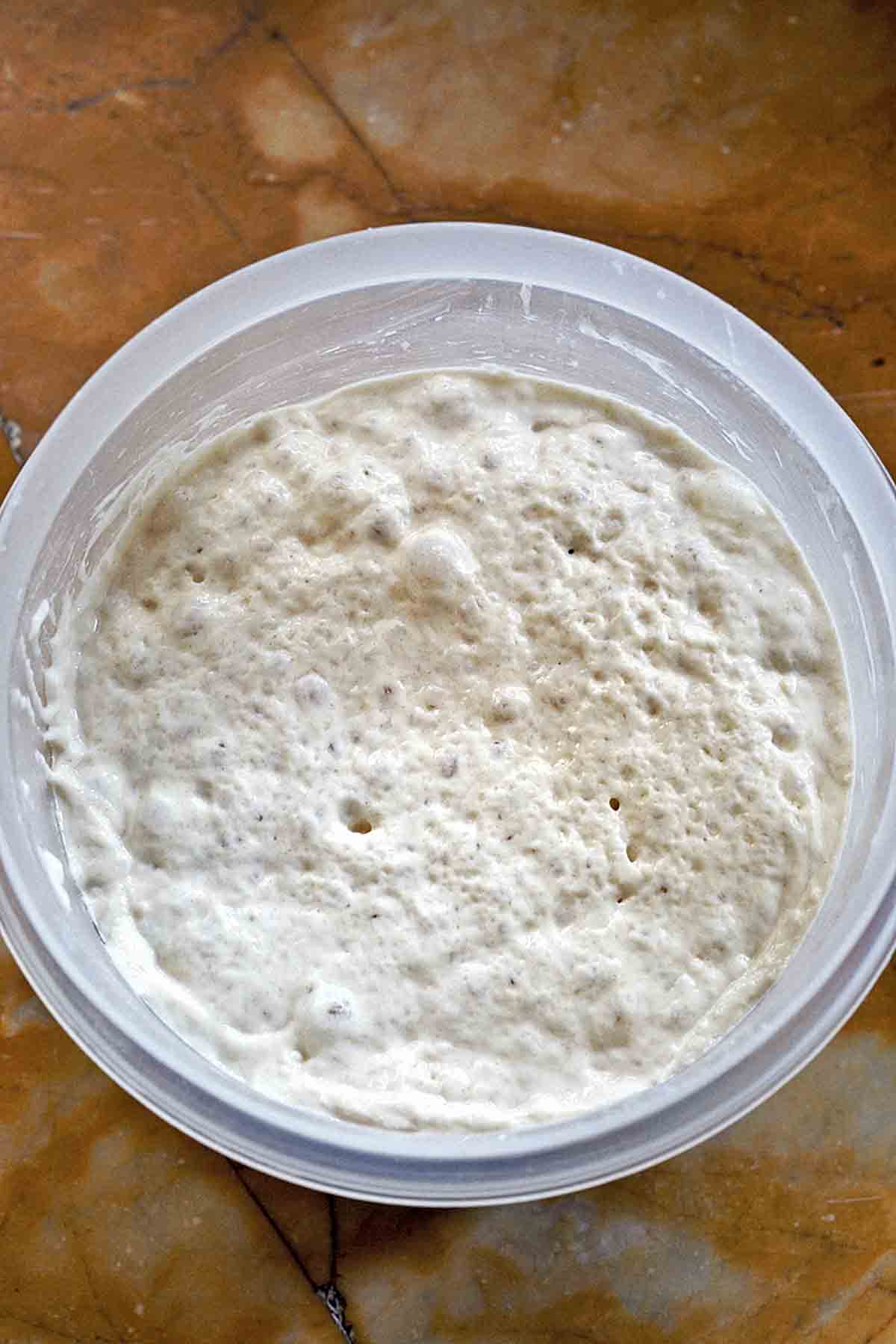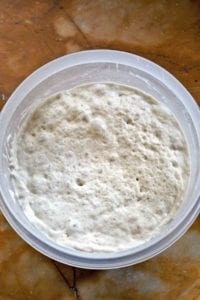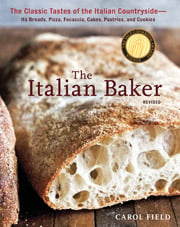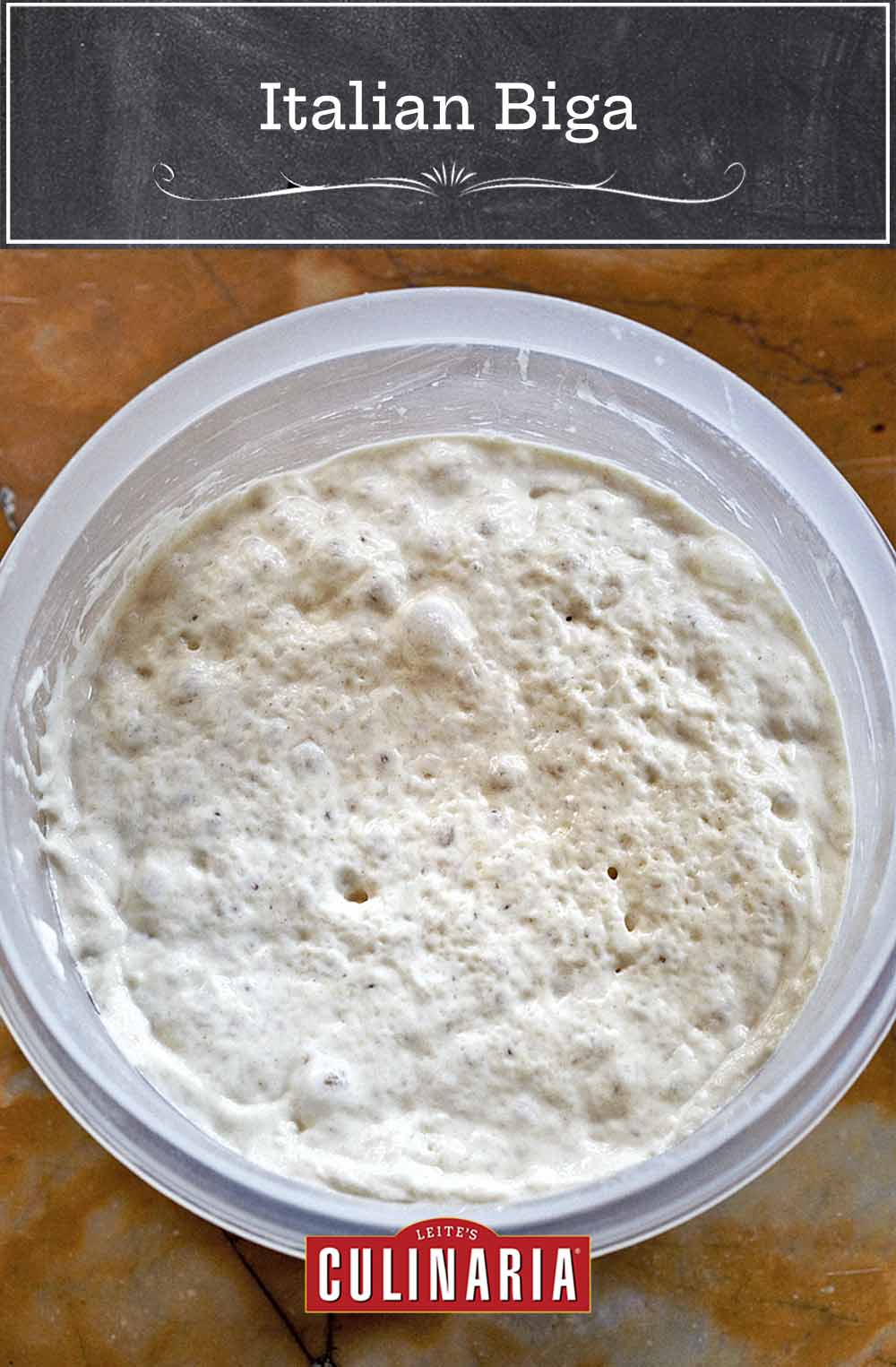
Many of the recipes for classic regional breads, such as this ciabatta recipe, begin with a starter dough made from small amounts of flour, water, and yeast allowed an initial fermentation. The starter, known as biga in Italy, or bighino when in small amounts, not only gives strength to what in Italy are weak flours, it also produces a secondary fermentation from which come the wonderful aroma, natural flavor, and special porosity of the final loaves and wheels of bread.
The important point about a biga is that the breads made with it develop a wonderful taste because their risings are long and bring out the flavor of the grain. Another benefit is that the loaves remain fresher and taste sweeter than those made with large amounts of commercial yeast.
In Italy, bakers use dough from the previous day’s baking to start a new dough. I keep some starter on hand at all times; by having it around, I can decide to make pane pugliese or ciabatta in the morning and have it for dinner that night. Because the first biga must come from somewhere, though, you may make it following the instructions below. It’s remarkable. It freezes very well and needs only about 3 hours at room temperature until it is bubbly and active again, or it can be refrigerated for up to 5 days.–Carol Field
LC Obliged to Biga Note
Behind each and every memorable bite of proper Italian bread we’ve daintily nibbled, hungrily inhaled, or otherwise somehow consumed, we have a biga to thank. So we’re feeling much obliged to Carol Field for this recipe. Nonna not included.

Italian Biga
Ingredients
- 1/4 teaspoon active dry yeast
- 1/4 cup warm water
- 3/4 cup plus 4 teaspoons water, preferably bottled spring water, at room temperature
- 2 1/3 cups unbleached all-purpose flour
- Vegetable oil, for the bowl
Instructions
- Stir the yeast into the 1/4 cup warm water and let stand until creamy, about 10 minutes.
- Stir the spring water into the creamy yeast mixture, and then stir in the flour, 1 cup at a time. If mixing by hand, stir with a wooden spoon for 3 to 4 minutes. If mixing with a stand mixer, beat with the paddle at the lowest speed for 2 minutes. If mixing with a food processor, mix just until a sticky dough forms.
- Transfer the biga to a lightly oiled bowl, cover with plastic wrap, and let rise at cool room temperature for 6 to 24 hours, until the starter is triple its original volume but is still wet and sticky. (The bakers I admire most advise 10 to 11 hours for the first rise, but others are very happy with the 24 hours it takes for dough to truly become yesterday’s dough, and if you like sour bread, allow your biga to rest for 24 to 48 hours or even 72 hours.)
- Cover and refrigerate or freeze the biga until ready to use. (If refrigerating the biga, use within 5 days. If freezing the biga, let it rest at room temperature for about 3 hours until it is bubbly and active again.) When needed, scoop out the desired amount of biga for your recipe and proceed. I strongly recommend weighing the biga rather than measuring it by volume since it expands at room temperature. If measuring by volume, measure chilled biga; if measuring by weight, the biga may be chilled or at room temperature.

Nutrition
Nutrition information is automatically calculated, so should only be used as an approximation.
Recipe Testers’ Reviews
This is a perfectly suitable starting point for most any bread which uses a starter. I bake bread several times a week and it’s nice to have this handy. Sometimes I add this to a bread dough which doesn’t call for a starter just for the added flavor.












Hi again, question #2. I have made my biga, I have included a picture it has been growing for 16 hours, so I think that is good. My question is your recipe in another link says the recipe will make 4 loaves. I want to make rolls. So how many rolls do you think I would get, but maybe that is how big i make them. But just asking. also what would the procedure be, Would I roll out the dough and cut into squares and fold into an envelope shape, meaning fold into thirds and then turn and fold again into thirds. I did this with another recipe from another baker and even though the rolls came out very nice, there was no OPEN CRUMB, that should be typical of Ciabatta. or should i just take the logs from the recipe and cut into smaller sections. Not sure how to go with this. Thank you for your time.
Your biga looks great, Camille! We haven’t tried making rolls with this dough, so I can’t say what the best approach would be. The dough for the ciabatta is incredibly wet, so you want to handle it as little as possible. I think you could probably either cut it into the number of rolls you want in the initial shaping step (step 3), or roll it into the cylinders and then cut each into individual rolls. I think the dough may be too wet to try and do any folding. Do let us know how it turns out!
Unless you are a baker, I think this should be free form. Less touching the better after rises 2-3. This is a great recipe, but I want a tweak it so that day 2-3 is better, as I think it dries out too quickly. Maybe potato addition? Maybe more oil or water??? I will play with it.
My tips are under proof is better than overproof. Good pizza dough if it could relax and stretch out better. I find I have to make pizza bases smaller and thicker.
Thanks, Ronnie. Do let us know what you come up with!
I’m new to baking! Wondering, how long can Biga stay in the freezer, if I’ve used once and have some leftover?
Getta, your biga should be fine in the freezer for up to 3 months.
What is the biga ratio in pizza dough recipe? Could I have pizza recipe using the biga? Please share your recipe. I’m from Myanmar.
Jason, we don’t have a pizza dough recipe specifically based on using biga. But if any of our readers do, we’d love to hear from you.
Hi, going to make biga today, but i use instant yeast. Can i just put all the water together? Thank you.
Yes, Camille, that should be fine since you’re using instant yeast.
I found a recipe for bread out of tiktok and now I realize it is a recipe for biga. But the original post baked it after the size tripled without mixing to dough. She just rolled it in some flour so it wasn’t so sticky then in it went to the baking dish. Is that ok? Baking biga alone???
Niki, from a safety perspective, it’s fine to bake it. Some people use it to make pizza crust. It contains the same ingredients as any other bread. The purpose of biga is to add flavor and strength to your loaf. I’ve never tried baking biga on its own, but I suspect that it would have a very strong sour flavor and might be quite chewy.